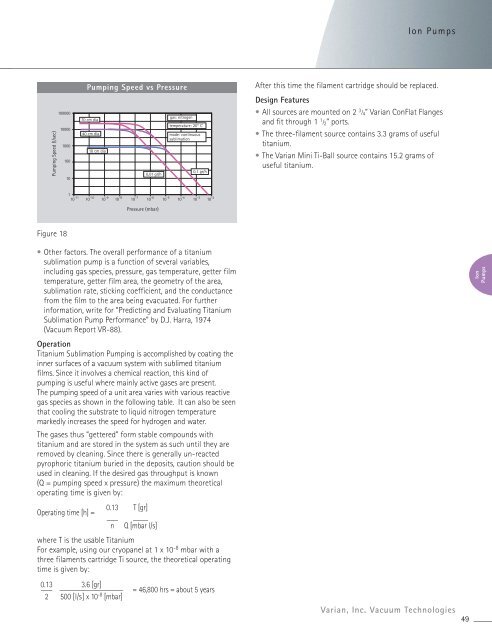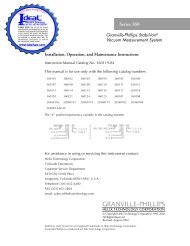Ion Pumps Varian, Inc. Vacuum Technologies - Ideal Vacuum Products
Ion Pumps Varian, Inc. Vacuum Technologies - Ideal Vacuum Products
Ion Pumps Varian, Inc. Vacuum Technologies - Ideal Vacuum Products
You also want an ePaper? Increase the reach of your titles
YUMPU automatically turns print PDFs into web optimized ePapers that Google loves.
<strong>Ion</strong> <strong>Pumps</strong><br />
Pumping Speed (l/sec)<br />
100000<br />
10000<br />
1000<br />
100<br />
10<br />
Pumping Speed vs Pressure<br />
70 cm dia<br />
40 cm dia<br />
10 cm dia<br />
0,01 gr/h<br />
gas: nitrogen<br />
temperature: 20° C<br />
mode: continuous<br />
sublimation<br />
0,1 gr/h<br />
After this time the filament cartridge should be replaced.<br />
Design Features<br />
• All sources are mounted on 2 3 ⁄ 4” <strong>Varian</strong> ConFlat Flanges<br />
and fit through 1 1 ⁄ 2” ports.<br />
• The three-filament source contains 3.3 grams of useful<br />
titanium.<br />
• The <strong>Varian</strong> Mini Ti-Ball source contains 15.2 grams of<br />
useful titanium.<br />
1<br />
10 -11<br />
10 -10 10 -9 10 -8 10 -7 10 -6 10 -5 10 -4 10 -3 10 -2<br />
Pressure (mbar)<br />
Figure 18<br />
• Other factors. The overall performance of a titanium<br />
sublimation pump is a function of several variables,<br />
including gas species, pressure, gas temperature, getter film<br />
temperature, getter film area, the geometry of the area,<br />
sublimation rate, sticking coefficient, and the conductance<br />
from the film to the area being evacuated. For further<br />
information, write for “Predicting and Evaluating Titanium<br />
Sublimation Pump Performance” by D.J. Harra, 1974<br />
(<strong>Vacuum</strong> Report VR-88).<br />
<strong>Ion</strong><br />
<strong>Pumps</strong><br />
Operation<br />
Titanium Sublimation Pumping is accomplished by coating the<br />
inner surfaces of a vacuum system with sublimed titanium<br />
films. Since it involves a chemical reaction, this kind of<br />
pumping is useful where mainly active gases are present.<br />
The pumping speed of a unit area varies with various reactive<br />
gas species as shown in the following table. It can also be seen<br />
that cooling the substrate to liquid nitrogen temperature<br />
markedly increases the speed for hydrogen and water.<br />
The gases thus “gettered” form stable compounds with<br />
titanium and are stored in the system as such until they are<br />
removed by cleaning. Since there is generally un-reacted<br />
pyrophoric titanium buried in the deposits, caution should be<br />
used in cleaning. If the desired gas throughput is known<br />
(Q = pumping speed x pressure) the maximum theoretical<br />
operating time is given by:<br />
Operating time [h] =<br />
0.13 T [gr]<br />
___ ____<br />
n Q [mbar l/s]<br />
where T is the usable Titanium<br />
For example, using our cryopanel at 1 x 10 -8 mbar with a<br />
three filaments cartridge Ti source, the theoretical operating<br />
time is given by:<br />
0.13 ___ _________________<br />
3.6 [gr]<br />
2 500 [l/s] x 10 -8 [mbar]<br />
= 46,800 hrs = about 5 years<br />
<strong>Varian</strong>, <strong>Inc</strong>. <strong>Vacuum</strong> <strong>Technologies</strong><br />
49

















